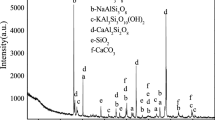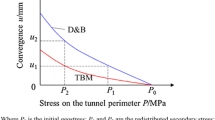Abstract
Mechanical behavior of the rock in tensile stress environment remains an unresolved problem in the underground mining, where surrounding rocks commonly experience tensile failure. In the present study, tensile failure behavior of three types of sedimentary rocks is investigated experimentally and numerically. The deformation response, fracture propagation, and splitting pattern as well as energy conversion of the rocks are examined in the Brazilian test with a testing machine, high-speed camera, and image scanning system. The tested rocks tend to show elastic-brittle-plastic deformation behavior in the biaxial stress state. Tensile strengths of the coal, mudstone, and sandstone are 1.2, 3.9, and 13.4 MPa, respectively. The coal and mudstone split in a static mode while the sandstone in dynamic mode. The splitting fracture initiates at the disk center in the coal and sandstone, and it emerges at the loading point in the mudstone. The fracture propagates more quickly in the rock with larger strength. It uses 1200.0, 5.8, and 0.4 ms, to break out sample surface of the coal, mudstone, and sandstone, respectively. The joint roughness coefficient (JRC) of the splitting fracture is largest (20.1) in the mudstone, followed by that in the coal (17.7), and it is smallest in the sandstone (15.3). A continuous-discontinuous coupling model, which is capable of analyzing the stress distribution and fracture propagation synergistically, is developed and calibrated against the experimental data. The numerical model accurately reproduces mechanical behavior of the tested rocks observed in the Brazilian test. The splitting fracture propagates along the maximum tensile stress plane in the sandstone. The propagation direction is locally influenced by the grain boundary with small tensile strength in the coal while, in the mudstone, the fracture is mainly formed along the grain boundary. Such differences in the fracture propagation path lead to the increasing trend from the JRC of the splitting surface in the sandstone to that in the coal and finally to that in the mudstone.
















Similar content being viewed by others
References
Andreev GE (1991a) A review of the Brazilian test for rock tensile strength determination. Part I: calculation formula. Min Sci Technol 13:445–456
Andreev GE (1991b) A review of the Brazilian test for rock tensile strength determination. Part II: contact conditions. Min Sci Technol 13:457–465
ASTM D3967–08 (2008) Standard test method for splitting tensile strength of intact rock core specimens. ASTM International, West Conshohocken
Coviello A, Lagioia R, Nova R (2005) On the measurement of the tensile strength of soft rocks. Rock Mech Rock Eng 38(4):251–273
Diederichs MS, Kaiser PK (1999) Tensile strength and abutment relaxation as failure control mechanics in underground excavations. Int J Rock Mech Min Sci 36:69–96
Fairhurst C (1964) On the validity of the Brazilian test for brittle materials. Int J Rock Mech Min Sci 1(4):535–546
Fuenkajorn K, Sippakorn K (2011) Laboratory determination of direct tensile strength and deformability of intact rocks. Geotech Test J 34(1):97–102
Garcia-Fernandez CC, Gonzalez-Nicieza C, Alvarez-Fernandez MI, Gutierrez-Moizant RA (2018) Analytical and experimental study of failure onset during a Brazilian test. Int J Rock Mech Min Sci 103:254–265
Hondros G (1959) The evaluation of Poisson's ratio and the modulus of materials of a low tensile resistance by the Brazilian (indirect tensile) test with particular reference to concrete. Aust J Appl Sci 10:243–268
Hudson JA, Brown ET, Rummel F (1972) The controlled failure of rock disc and rings loaded in diametral compression. Int J Rock Mech Min Sci 9:241–248
ISRM (1978) Suggested methods for determining tensile strength of rock materials. Int J Rock Mech Min Sci Geomech Abstr 15:99–103
Jang HS, Kang SS, Jang BA (2014) Determination of joint roughness coefficients using roughness parameters. Rock Mech Rock Eng 47:2061–2073
Khosravi A, Simon R, Rivard P (2017) The shape effect on the morphology of the fracture surface induced by the Brazilian test. Int J Rock Mech Min Sci 93:201–209
Kourkoulis SK, Markides CF, Chatzistergos PE (2013) The standardized Brazilian disc test as a contact problem. Int J Rock Mech Min Sci 57:132–141
Labuz JF, Cattaneo S, Chen L (2001) Acoustic emission at failure in quasi-brittle materials. Constr Build Mater 15(5):225–233
Lanaro F, Sato T, Stephansson O (2009) Microcrack modeling of Brazilian tensile test with the boundary element method. Int J Rock Mech Min Sci 46:450–461
Li D, Wong LNY (2013) The Brazilian disc test for rock mechanics applications: review and new insights. Rock Mech Rock Eng 46:269–287
Lundborg N (1967) The strength-size relation of granite. Int J Rock Mech Min Sci Geomech Abstr 4(3):269–272
Ma YF, Huang HY (2018) DEM analysis of failure mechanisms in the intact Brazilian test. Int J Rock Mech Min Sci 102:109–119
Ma TS, Wu BS, Fu JH, Zhang QG, Chen P (2017a) Fracture pressure prediction for layered formations with anisotropic rock strengths. J Nat Gas Sci Eng 38:485–503
Ma TS, Zhang QB, Chen P, Yang CH, Zhao J (2017b) Fracture pressure model for inclined wells in layered formations with anisotropic rock strengths. J Pet Sci Eng 149:393–408
Ma TS, Peng N, Zhu Z, Zhang QB, Yang CH, Zhao J (2018) Brazilian tensile strength of anisotropic rocks: review and new insights. Energies 11(2):304
Markides CF, Pazis DN, Kourkoulis SK (2010) Closed full-field solutions for stresses and displacements in the Brazilian disk under distributed radial load. Int J Rock Mech Min Sci 47:227–237
Mellor M, Hawkes I (1971) Measurement of tensile strength by diametral compression of discs and annuli. Eng Geol 5:173–225
Patel S, Martin CD (2018) Evaluation of tensile Young’s modulus and Poisson ratio of a bi-modular rock from the displacement measurements in a Brazilian test. Rock Mech Rock Eng 51:361–373
Perras MA, Diederichs MS (2014) A review of the tensile strength of rock: concepts and testing. Geotech Geol Eng 32(2):525–546
Shabanimashcool M, Li CC (2012) Numerical modelling of longwall mining and stability analysis of the gates in a coal mine. Int J Rock Mech Min Sci 51:24–34
Steen BVD, Vervoort A, Napier JAL (2005) Observed and simulated fracture pattern in diametrically loaded discs of rock material. Int J Fract 131:35–52
Stirling RA, Simpson DJ, Davie CT (2013) The application of digital image correlation to Brazilian testing of sandstone. Int J Rock Mech Min Sci 60:1–11
Tatone BSA, Grasselli G (2010) A new 2D discontinuity roughness parameter and its correlation with JRC. Int J Rock Mech Min Sci 47:1391–1400
Timoshenko SP, Goodier JN (1970) Theory of elasticity, 3rd edn. McGraw-Hill, New York
Turichshev A, Hadjigeorgiou J (2015) Experimental and numerical investigations into the strength of intact veined rock. Rock Mech Rock Eng 48(5):1897–1912
Vervoort A, Min KB, Konietzky H, Cho JW, Debecker B (2014) Failure of transversely isotropic rock under Brazilian test conditions. Int J Rock Mech Min Sci 70:343–352
Wang JC, Wang ZH, Yang SL (2017) A coupled meso- and macro- mechanical model for heterogeneous coal. Int J Rock Mech Min Sci 94:64–81
Wang JC, Wei WJ, Zhang JW (2019a) Theoretical description of drawing body shape in an inclined seam with longwall top coal caving mining. Int J Coal Sci Tech 7:182–195
Wang JC, Yang SL, Yang BG, Li Y, Wang ZH (2019b) Roof sub-regional fracturing and support resistance distribution in deep longwall face with ultra-large length. J China Coal Soc 44(1):54–63 (in Chinese)
Wei XX, Chau KT (2013) Three dimensional analytical solution for finite circular cylinders subjected to indirect tensile test. Int J Solids Struct 50:2395–2406
Wu SC, Ma J, Cheng Y, Xu M, Huang X (2018) Numerical analysis of the flattened Brazilian test: failure process, recommended geometric parameters and loading conditions. Eng Fract Mech 204:288–305
Xu XL, Wu SC, Gao YT, Xu M (2016) Effects of micro-structure and micro-parameters on Brazilian tensile strength using flat-joint model. Rock Mech Rock Eng 49:3575–3595
Yuan R, Shen B (2017) Numerical modelling of the contact condition of a Brazilian disk test and its influence on the tensile strength of rock. Int J Rock Mech Min Sci 93:54–65
Zhou YX, Xia K, Li XB, Li HB, Ma GW, Zhao J, Zhou ZL, Dai F (2012) Suggested methods for determining the dynamic strength parameters and mode-I fracture toughness of rock materials. Int J Rock Mech Min Sci 49:105–112
Acknowledgments
This study is sponsored by National Key R&D Program of China (Grant No. 2017YFC0603002) and National Natural Science Foundation of China (No. 51934008, 51904304). It is also supported by the Fundamental Research Funds for the Central Universities. The authors are grateful for their support.
Author information
Authors and Affiliations
Corresponding author
Rights and permissions
About this article
Cite this article
Wang, Z., Yang, S. & Tang, Y. Mechanical behavior of different sedimentary rocks in the Brazilian test. Bull Eng Geol Environ 79, 5415–5432 (2020). https://doi.org/10.1007/s10064-020-01906-8
Received:
Accepted:
Published:
Issue Date:
DOI: https://doi.org/10.1007/s10064-020-01906-8




